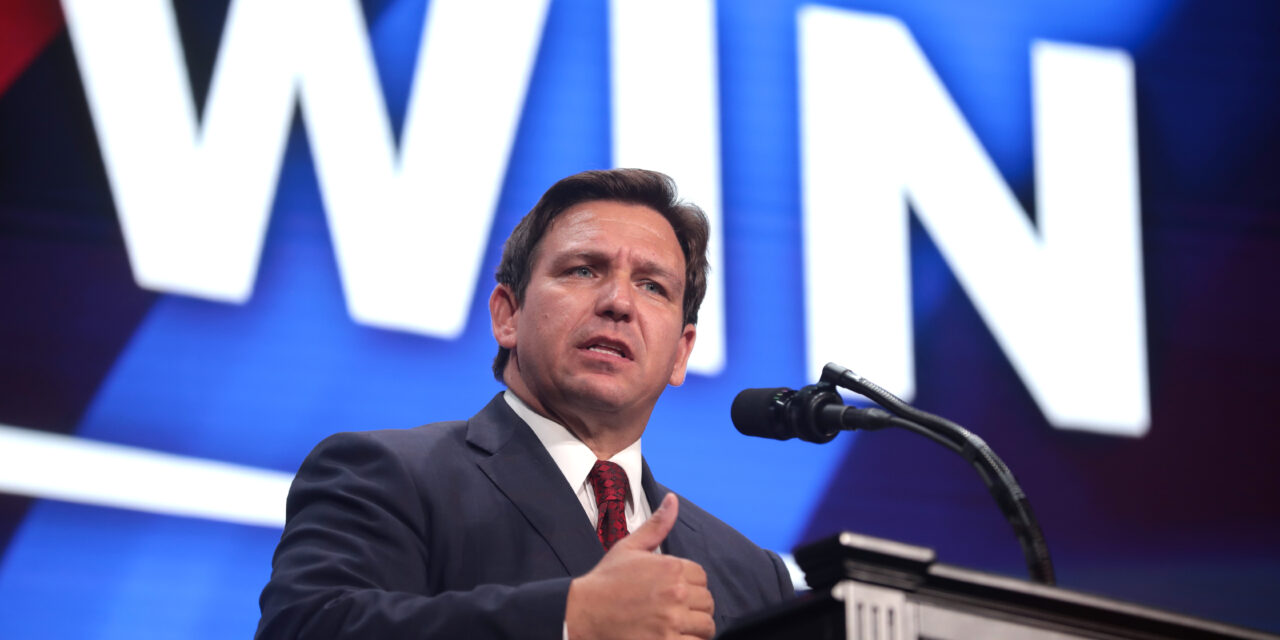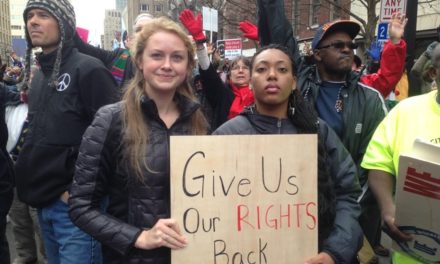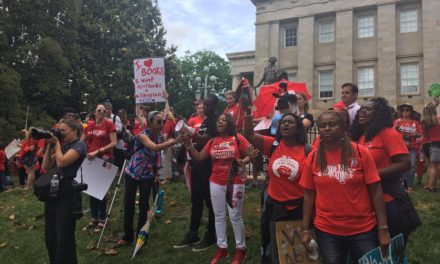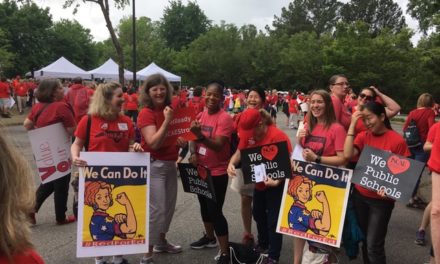“I do what I think is best for kids,” said Lauren Leto, a career public school educator at Brandon High School in Hillsborough County, Florida. “That’s my hill I’m ready to die on,” she told Our Schools.
What’s “best for kids” according to Leto, and most other educators, includes attending to their mental health needs, especially their feelings of anxiety, depression, and other symptoms related to trauma. Leto insists that a big part of that is ensuring students feel they are welcome and safe in a school environment that supports who they are, what they’re interested in, and how they choose to present themselves to the world.
These commitments have become a risky proposition in a state like Florida where educators have become fearful of being fired—“or even criminally charged,” as NBC News reports—because of Florida state laws that attempt to crack down on how schools address students’ mental health.
Under the leadership of Republican Governor Ron DeSantis, Florida lawmakers and state officials have enacted a raft of laws targeting schools for what DeSantis and other right-wing advocates charge is “indoctrinating” students in “woke ideology.” Proponents of this supposed anti-woke agenda seem at a loss to explain everything their cause entails, but in Florida, DeSantis and Republican lawmakers have set their sights on many of the things teachers do to attend to their students’ mental health and ensure classrooms are welcoming places, especially for students of color and students who identify as LGBTQ+.
As a result of these laws, Florida teachers who use learning materials, classroom signs, and flags to signal their support of racial, gender, and religious diversity have been told to remove these materials, and they’ve been subjected to investigation by the state, and targeted for firing as well. School librarians have cleared their shelves of any books that could possibly have racial or sexual content, and teachers have spoken openly about how their students increasingly “feel less safe and less heard in a place where they spend the majority of their time.”
Another target of the anti-woke attack is social-emotional learning (SEL), a practice teachers engage in to help their students develop essential mental health skills such as self-control, behavior management, and cultivating positive relationships with others. Teachers have always used SEL—whether it was called that or not. But right-wing advocates and politicians, including DeSantis and other Florida lawmakers, claim SEL is part of the woke agenda.
“It’s almost an embarrassment to be in education in Florida,” said Leto. Yet, her commitment to her students’ mental health is not just a personal preference; it’s a cornerstone of an approach to schooling that has been embraced by her entire school and other schools in the district. The approach, commonly called community schools, calls upon schools to act as hubs for students and families to access a wide range of services, including mental health services. Leto serves as the community school coordinator at Brandon.
The community schools approach has been catching on in public schools nationwide to the extent that some are now calling it a “movement.” A number of states—including California, Kentucky, Maryland, and New York—have made significant investments in spreading the community schools approach. Legislation introduced in Congress in 2023 would allocate $3.6 billion in new funding for expanding community schools in low-income school districts. According to an annual surveyconducted by the federal government’s National Center for Education Statistics (NCES) for the school year 2023-2024, 60 percent of public schools claim to use some form of a community school model or “wraparound services,” a term often used to describe school-provided services that are not strictly academically related. The wraparound services schools most frequently provide are mental health (66 percent) and nutrition and food (55 percent), according to NCES.
But the growing popularity of the community schools idea seems to be on a collision course with Florida laws—and similar laws that have been considered and adopted in South Carolina, Tennessee, Texas, and other states—that police how educators deal with their students’ questions, feelings, and experiences related to mental health.
But rather than giving in to government intimidation, Leto and her Brandon High School colleagues explain why and how their commitment to the community schools approach is unwavering.
A Team Effort
Tracee Phillips knew, well before the COVID pandemic, that Brandon students were struggling with mental health issues. As the school’s former social worker—she became the district coordinator for social work services in 2023—she routinely dealt with students experiencing anxiety and depression, she said. The sources for these two issues were multiple, including food insecurity, parents working multiple jobs and not being at home, threats of becoming unhoused, parent unemployment, family member incarceration, and divorce, according to Phillips.
But when students came back to in-person learning, it was clear that the impact of the pandemic had exaggerated their mental health trauma.
As concerns about student mental health heightened, Phillips credits Brandon principal Jeremy Klein for introducing the idea of the community schools approach into the conversation. The concept was already being used successfully in some Hillsborough County elementary schools, and district leaders were offering grant money to middle and high school educators who would be willing to pilot the approach in their schools. After introducing the idea and giving teachers and staff members time to learn about it, Klein put the idea up for a vote and it passed.
Although Phillips initially feared the added responsibilities entailed as part of the community schools approach would fall mostly on her, she was relieved when Leto was hired as the community school coordinator.
She also quickly understood that implementing this approach was a team effort that would ultimately involve everyone in the school, including the participation of parents and students. The implementation kicked off with an assessment—what Leto called a “listening project”—of what Brandon students and parents felt were their most urgent needs and whether or not there were existing services to meet those needs.
What the listening project turned up, according to Leto, would ultimately help the school prioritize its collective response. Among students, the top three needs were for the school to provide a school pantry with free food, clothes, and hygiene items, access to free school supplies, and job opportunities. Parents felt that increased support for their children’s mental health was a top three need, along with a food pantry for families, and job opportunities for parents and students.
Phillips also credits the listening project, and the implementation of the community schools approach altogether, with creating “a heightened awareness” among school staff about the need to create more partnerships with outside agencies that could help with mental health and other requirements.
‘Getting What They Really Needed’
Starting the school’s new pantry would also prove to be a team effort.
Phillips had previously created a pantry during the pandemic lockdown, but funding dried up and the school’s attention turned elsewhere. But she still had contacts who were willing to help with donations and funding.
Finding a location for the pantry, though, involved help from Brandon’s school librarian, Nicole Huff.
Huff had long referred to the library as the “hub of the school,” as it sits in the exact center of the school and intersects with the building’s main hallways.
“I encourage kids to come to the library for all kinds of reasons,” Huff said, “even if it’s just to take a break.”
The library also could provide the space needed for the pantry since it had a vacant room that had been used to store VHS tapes. Volunteers painted the walls of the room with colorful murals and filled shelves with school supplies, hair care products, and items for personal hygiene. Eventually, the school added a clothes closet and food items to the pantry, and student assistants took over monitoring the pantry and helping with maintaining the shelves.
At first, students weren’t coming to the pantry, and Huff overheard some of them saying they “didn’t want people to think they were poor.” However, a breakthrough occurred when there was a sudden cold snap and students showed up at school without warm clothes. That gave her the idea to take the pantry’s collection of jackets and hoodies out of the clothes closet and display them at the pantry entrance so students could take the warm clothing.
Now, students come to the pantry after physical education to get deodorant, Huff said. If they’ve had a clothing mishap, they can get something else to wear. Students who haven’t brushed their teeth because they had to spend the night at a friend’s house can come in to get a toothbrush and toothpaste. The pantry keeps feminine hygiene products on hand also.
“The stigma of the pantry as being just for low-income kids totally changed because students realized they were getting what they really needed.”
Listening Projects and Pantries
Listening projects and pantries have everything to do with student mental health, according to Brandon educators.
“When schools really listen to what students say they need, and respond, it gives students a greater sense of belonging and being valued,” Leto said. “They can see they are no longer alone.”
For instance, when Leto learned that some students from low-income families couldn’t afford a trip to the salon before the annual homecoming, she organized a hair and makeup event. Students who identified as Black or Hispanic were surprised when they saw there would be volunteer stylists who knew how to style their hair and do their makeup. “This said to them, ‘Yes, I see you,’” Leto said.
Phillips credits the transition to the community schools approach with creating a widespread understanding among school staff, students, and parents that Brandon is a community and, “We’re all in this together,” she said. This new communal attitude “helps students feel connected to something much larger than themselves,” she said. “It gives them a sense of belonging, which directly leads to improved mental health.”
Huff told the story of a student who was unhoused and lived in a car but was, at first, reluctant to talk about her situation. Yet, after visiting the pantry for the first time and finding there was food to take back to her family, she became a regular visitor and began talking more openly about her family’s struggles. “One day, the student blurted out, ‘People here care,’” said Huff, “as if it surprised her.”
‘How I Found Myself in the Library’
Huff’s determination to be responsive to students’ mental health needs is also reflected in how she runs the library, even when it puts the school at risk of going against the state’s new rules.
“I help students find books with the information they tell me they need, and I make sure that information is accurate,” she said. “I don’t judge them for what type of information they’re looking for.”
“I have books on drugs and drug addiction because our students are exposed to that in their lives and need to know about the dangers. I have books about how to avoid [sexually transmitted diseases] because teenagers need to know about that. I have books in which there are characters who overcome trauma because these stories can help students better understand how they can do that for themselves.”
Every year, Huff conducts a lesson she calls, “I found myself in the library.” She arranges books around the library based on their narrative points of view—books with boy or girl narrators; books with Asian, white, Black, or Hispanic narrators; books with narrators who identify as LGBTQ+; and books with narrators who come from low-income or unhoused circumstances. Students get to circulate throughout the library to look at the book covers and pick a book that might interest them. After the students choose a book and read it, they’re asked to write a short statement about the book with the theme, “How I found myself in the library.” At the end of the project, the students’ statements go on a banner in the library.
“Books can be mirrors for students to see themselves or they can be windows to see others who are very different from themselves,” she said. Either way, Huff contends, their experiences with books can be mentally self-affirming.
Running the Risk
Brandon educators are aware of the political situation in the state that could put them at odds with Florida state laws.
“We’re not supposed to say social-emotional learning in Florida, so [at Brandon] we say emotional intelligence.” Leto said. The district had a social-emotional learning department, so administrators changed the name to the department of resiliency, character, and life skills education.
Many of the books Huff has in the library have been challenged in other Florida school districts and sometimes removed from library shelves. And on the rare occasion when a Brandon parent says she doesn’t want her child exposed to a particular book, Huff complies.
“Parents are right to control what’s developmentally appropriate for their children,” she said, “but not for everybody else’s.”
To book-banning advocates who don’t have children enrolled at Brandon, she counters, “When we remove a book because someone believes the content isn’t appropriate, we’re telling students who might identify with the book that they aren’t appropriate.”
Fortunately, Brandon High School educators appear to be in a district that supports their efforts to bolster their students’ mental health. For example, in October 2023, the Hillsborough board voted unanimously to recognize LGBTQ+ History Month.
Nevertheless, as long as the current leadership in Florida stays the same, there will doubtlessly be more attempts to undermine public schools. After Our Schools spoke with Brandon educators, state officials issued yet another edict targeting public schools and the work they do, this time declaring, according to the Tallahassee Democrat that, “Public school libraries are ‘a forum for government speech,’ not a ‘forum for free expression.’”
But that’s not going to stop Leto and her colleagues from maintaining their commitment to the community schools approach. “Sure, there are political and economic aspects to implementing the community schools approach,” she conceded, “but at the very core, it’s about supporting kids.”
(Photo by Gage Skidmore via Flickr Creative Commons, CC BY-SA 2.0.)






Recent Comments